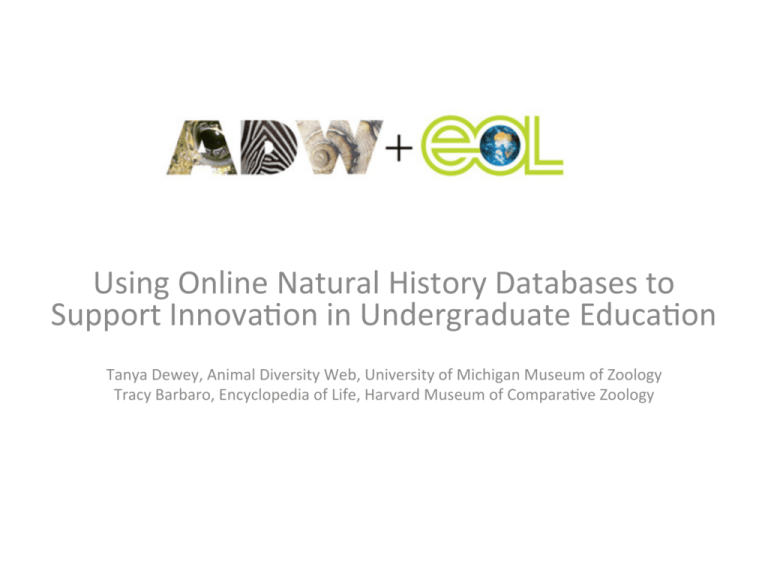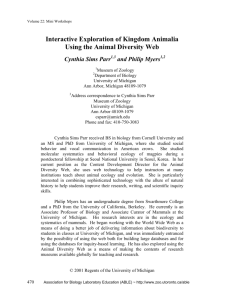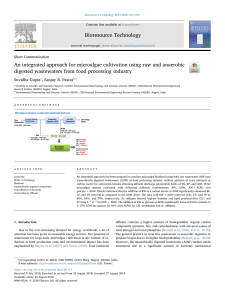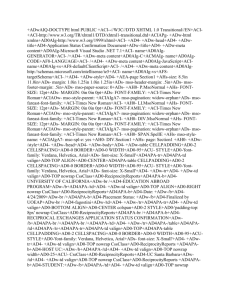3:00 PM, Using Online Natural History Databases to Support
advertisement

Using Online Natural History Databases to Support Innova8on in Undergraduate Educa8on Tanya Dewey, Animal Diversity Web, University of Michigan Museum of Zoology Tracy Barbaro, Encyclopedia of Life, Harvard Museum of Compara8ve Zoology The Animal Diversity Web (animaldiversity.org, ADW) and Encyclopedia of Life (eol.org, EOL) work together to provide and disseminate natural history informa8on useful in educa8on. Long term collabora8on: sharing data and ideas • ADW is an EOL content partner • EOL page re-­‐directs on ADW • Providing complementary resources: Use of EOL tools in ADW/Center for Essen8al Science curriculum. ADW BioKIDS CriRer Catalog provides kid-­‐friendly content. Communicate about structuring student species account contribu8ons. • Online database focusing on animals, online since 1995. • Structured content contribu8on model, undergraduate biology students write accounts, which are then edited for accuracy and completeness. • 2 to 4 million pages served to 300,000 sers monthly. One ofuthe largest natural history databases online.! 4 million pagesincluding to 300,000specimens users monthly.! • 4000 animaldiversity.org! taxon accounts, thousands 2of totagged images, and live animals. Majority educational use.! • Majority educa8on use. • • • • Global, on-­‐line resource—plants, animals, microorganisms Web pages for 1.9 million known species Plus millions more yet to be described Serves authorita8ve informa8on as well as contribu8ons from the general public. Workshop Agenda Introduc8on to ADW and Tools Introduc8on to EOL and Tools Wrap up and discussion animaldiversity.org! One of the largest natural history databases online.! 2 to 4 million pages to 300,000 users monthly.! Majority educational use.! ² ADW History:! ² Nearly 4000 high quality, vetted, student-authored accounts.! ² Online since 1995, over 2 million pages served to 300,000 visitors monthly.! ² 20,000 tagged images.! ! ! ² How is the database built?! ² Over 4000 students from 60 institutions have contributed.! ² Students contribute through an online template, resulting in a highly structured database.! ² How is the database used?! ² Re-purpose data via presentation.! ² Mine the data for active inquiry in classrooms.! ² Connect to other databases via structure and tagging.! ! ² ADW History:! ² Nearly 4000 high quality, vetted, student-authored accounts.! ² Online since 1995, over 2 million pages served to 300,000 visitors monthly.! ² 20,000 tagged images.! ! ! ² How is the database built?! ² Over 4000 students from 60 institutions have contributed.! ² Students contribute through an online template, resulting in a highly structured database.! ² Incorporate external data and add data to images.! ² How is the database used?! ² Re-purpose data via presentation.! ² Mine the data for active inquiry in classrooms.! ² Connect to other databases via structure and tagging.! ! ² ADW History:! ² Nearly 4000 high quality, vetted, student-authored accounts.! ² Online since 1995, over 2 million pages served to 300,000 visitors monthly.! ² 20,000 tagged images.! ! ! ² How is the database built?! ² Over 4000 students from 60 institutions have contributed.! ² Students contribute through an online template, resulting in a highly structured database.! ² How is the database used?! ² Re-purpose data via presentation.! ² Mine the data for active inquiry in classrooms.! ² Connect to other databases via structure and tagging.! ! animaldiversity.org/q! ² Very large, structured database permits flexible querying so students can discover patterns in natural history. Ideally suited for active inquiry in a wide variety of organismal and introductory biology courses.! ! ! ² Data available for queries includes geographic range, diet, size parameters, habitat, behaviors, and many other species-level characteristics.! ! ² Queries of tagged specimen images illustrate morphological adaptations.! ! ² Queries of live animal images illustrate life stages, anatomies, and behaviors.! ² Query section allows students to identify a group of animals that they want information on.! ² Report section allows students to specify the information they want.! ² An example query follows . . .! Query for bats! native to the! Nearctic.! Report primary! diet.! Show images of skull morphology.! Select “submit.”! Report is presented in the browser window and is downloadable.! Registered users can save queries and results in their “backpack.”! Possible queries are almost limitless.! ! ² Instructors appreciate the opportunity to incorporate active inquiry into undergraduate biology classrooms.! ² Students enjoy activities and report greater knowledge, skills, and confidence after query exercises. ! ² Implemented in over 20 undergraduate institutions and a wide variety of courses.! ² Example activities are designed to be readily incorporated into introductory biology, zoology, behavior, and ecology courses.! ! Give it a try!! ! animaldiversity.org/q! ! or! ! https://animaldiversity.ummz.umich.edu/quaardvark! ! or contact us at adw_staff@umich.edu!

![Subject: [ADW] I have multiple students in my Mammalogy class this](http://s3.studylib.net/store/data/008229753_1-ddb84ce252c8600771fddf03570564cf-300x300.png)






